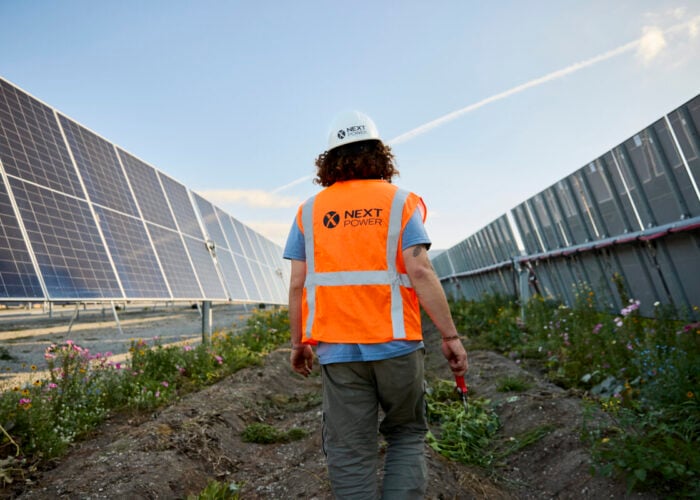
President Trump’s administration would be “shooting itself in the foot” if it closed the US department of energy’s Sunshot Initiative, according to the programme’s former director Minh Le.
Speaking to PV Tech, Le said the scheme had contributed to building a stable solar industry supporting 375,000 jobs and contributing US$25 billion to the US economy. There is little clarity so far on the details of Trump’s energy plans beyond the expansion of fossil fuel drilling rights and an anticipated rollback of regulations on coal power plants.
Try Premium for just $1
- Full premium access for the first month at only $1
- Converts to an annual rate after 30 days unless cancelled
- Cancel anytime during the trial period
Premium Benefits
- Expert industry analysis and interviews
- Digital access to PV Tech Power journal
- Exclusive event discounts
Or get the full Premium subscription right away
Or continue reading this article for free
DoE staff have been barred from communicating with the press or using social media, however, Le, who headed up Sunshot from November 2012 till October 2015 has now left government after a stint in Obama’s budget office. He strongly believes the numbers behind Sunshot make a compelling case for its retention.
“I don’t think anyone who looks at the data can argue against it. We have hard data that shows it’s working. It’s creating jobs, it’s growing our GDP. If you want to go backwards then you turn that off,” said Le, who was speaking in a strictly personal capacity. “The only rational argument is to continue on but there are a number of ideological reasons why this administration might want to cut it but if they do so, they’ll be shooting themselves in the foot because it would be harmful to the US economy for them to do so.
“The economic argument is extremely powerful. There was a study done recently that said that the solar value chain in the US is worth in the order of US$25 billion a year. That’s big business. Solar employs around 370,000 across America. And another statistic that is important to a lot of people in our country, armed forces veterans coming back from Afghanistan, Iraq etc, they make up 8% of the solar workforce. That’s higher than most sectors,” explained Le.
One of the programmes that has enabled this is a partnership between the Sunshot Initiative and the Department of Defence called Solar Ready Vets, which trains armed service members before they leave the forces.
“We have solar industry today that is doing well and I believe that under this administration it should continue to do well. It’s economically competitive in many regions, at various scales and consumers want it. A recent poll suggested that 76% of [US] voters want more emphasis on solar energy. That’s phenomenal and it crosses both sides of the aisle. This should not be a polarising issue for America. It’s about energy security and economic growth and that's the most significant factor people should look at. A DoE study found that there are 370,000 jobs in solar, it has one of the highest growth rates of any sector.”
Jobs
President Trump has been vociferous in his support of the US coal industry vowing to bring jobs back to the sector, while taking several opportunities on the campaign trail to talk down renewable energy. Le stresses the importance of not linking the two industries’ fates.
“This notion that solar is taking away coal jobs is a false narrative. Solar only represent 1.5% of our generation capacity, it’s growing but it’s not the reason why coal jobs are leaving. That narrative pits solar workers against coal workers and that’s not true,” he said.
Global coal prices and a revival of US natural gas production have been the root cause of coal mining’s difficulties. Pledges to revive it received a cool reception from one coal magnate who doubted Trump’s ability to overcome powerful, global market forces.
With the Initiative’s goal to reach US$1 per Watt for utility-scale solar seemingly achieved ahead of the 2020 target, could opponents argue that Sunshot has achieved what it set out to do?
“The work is not done. Certainly at the utility-scale the trends are in the right direction but the work is not done. We still have high costs for residential and commercial solar and there is great work that can continue to happen here.”
He points to two further success stories of Sunshot in the area of research and development and early-stage business growth. The scheme invested around US$150 million through its incubator programme and those companies have gone on to raise US$3.5 billion. Meanwhile, Le claimed the US is behind half of global solar efficiency records.
“Solar is an economic choice. It’s growing businesses in our economy, it’s creating jobs. Putting the brakes on that would be damaging to the US economy. I think cooler heads will prevail. Initially there may be rhetoric but eventually, the new administration will have to get around to governing and they will soon realise that economic growth and job creation is not a partisan issue. You're in office to help the nation move forward and grow. You may differ in opinion on the best way to do that. But if you look at the data, you want to award the things that are working, and create jobs and economic growth in the country.
“A rational business leader would view this as a growth sector of the economy. It’s exciting. What’s not to like?”






